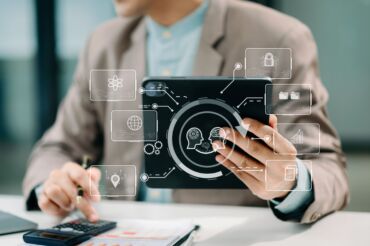The term “artificial intelligence” (AI) has come to mean many things, from the brains behind such digital assistants as Siri and Alexa to the supposedly unstoppable technological force that will eventually take everyone’s job away. In truth, however, AI is really just another tool developed by humans to help them perform certain tasks faster and easier. The technology may be complex, but the goal of its use — to improve human capabilities — is no more mysterious than using a rock to crack a walnut.
Solving work problems with AI
At Thomson Reuters, AI research and development takes place in the Thomson Reuters Labs. There, teams of engineers and designers study work problems encountered by Thomson Reuters customers, then devise ways to solve those problems using various forms of cognitive computing, including machine learning and artificial intelligence, or AI.
When it comes to developing AI capabilities, Thomson Reuters is laser-focused on innovating practical AI applications that will help its customers work smarter, make better decisions, and ultimately generate more value for their organizations.
For example, AI-powered products such as Westlaw and Checkpoint are designed to help legal and accounting professionals do their jobs by giving them faster, easier ways to access and process the information they seek. The genesis of these products is in asking — and answering — such questions as: “How can we help knowledge workers find the information they need at the point where they need it?” and “How can we remove obstacles between data and the user to create a more useful and rewarding experience?”
The intelligence behind Thomson Reuters solutions
Thomson Reuters is a hybrid organization that leverages its expertise in both technology and media to support and spur technical innovation. For more than a century, Thomson Reuters has been collecting and refining massive amounts of proprietary data, all of which is aimed at helping governments, legal professionals, and corporations conduct their business more effectively. At the same time, Thomson Reuters has assembled a world-class organization of subject-matter experts (practicing attorneys, tax specialists, researchers, organizational consultants, etc.) who provide the deep knowledge required to produce the product “intelligence” — artificial or otherwise — that Thomson Reuters customers have come to expect.
Whether it’s lawyers using Westlaw or tax professionals using Checkpoint, Thomson Reuters has developed the systems and search capabilities necessary to connect these knowledge workers with the data and insight they need to perform their jobs at the highest possible level. And each day, while product development teams work to improve the existing customer experience, the researchers and designers in Thomson Reuters Labs are looking for ways to transform that experience through innovative new applications of machine learning and cognitive computing.
How AI helps knowledge workers
Many of the problems encountered by today’s knowledge workers involve extracting very specific types of information from vast and ever-expanding amounts of data. These are good problems for AI to solve, because AI algorithms can identify needles of knowledge in haystacks of data much faster than a human being. For example, lawyers using Westlaw can now identify relevant legal precedents in a matter of seconds, and accountants using Checkpoint have at their fingertips a digital “assistant” who knows the tax rules governing all the states in the U.S., Canada, and Puerto Rico.
In practice, these capabilities reduce hunt-and-peck busywork to a minimum, freeing up legal and tax professionals to do what AI cannot, which is apply judgment, creativity, synthesis and context to the data, thereby creating the meaning and value that today’s knowledge workers are paid to produce. For attorneys, that might mean using AI-assisted tools to run document analytics and develop data-supported litigation strategies. For accountants, it could mean using corporate tax data to model forward-looking scenario analytics and support more strategic, data-based decision-making in the C suites.
Continuous AI innovation
At Thomson Reuters, developing and applying AI’s unique capabilities also means finding ways to remove the technical barriers between a customer with a question and the answer they are looking for. That’s why Thomson Reuters has invested so much time and energy into developing search capabilities that utilize “natural language processing,” or NLP. NLP technology is useful because people don’t always know exactly what they are looking for, so NLP allows them to formulate search questions in everyday language. AI-enabled search tools then extrapolate the best answer from whatever verbal clues the user provides, whether the question is fully formulated or not.
For customers, NLP capabilities are just another way to make Thomson Reuters products easier to use. But behind the scenes, developing an accurate, intuitive form of NLP represents an extraordinary technological achievement. The company’s commitment to continuous innovation made it possible, but so did a century’s worth of institutional knowledge and technical expertise.
Enhancing productivity and competitiveness
Today, the field of cognitive computing is evolving so quickly that new possibilities are opening up every day. Various forms of machine learning and artificial intelligence now guide computer systems in most major industries, from agriculture and aviation to finance, medicine, automobiles, e-commerce, government, education, media, and many other fields. Cognitive computing is also changing the way many knowledge workers do their jobs, providing lawyers, accountants, business consultants, compliance officers, and other professionals with the tools they need to enhance their productivity and competitiveness.
Thomson Reuters has been at the forefront of developing practical business applications for AI, and Thomson Reuters customers are the beneficiaries of this effort.
For more information, visit the Thomson Reuters Lab hub on artificial intelligence.












